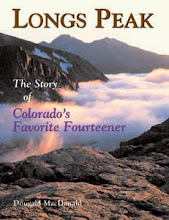 “Notwithstanding any other authority of law, the mountain located 63 degrees 04 minutes 12 seconds north, by 151 degrees 00 minutes 18 seconds west shall continue to be named and referred to for all purposes as Mount McKinley.”
“Notwithstanding any other authority of law, the mountain located 63 degrees 04 minutes 12 seconds north, by 151 degrees 00 minutes 18 seconds west shall continue to be named and referred to for all purposes as Mount McKinley.”
That’s the full language of House Resolution 198, introduced January 4, on schedule, by Ohio Rep. Ralph Regula, who has sponsored legislation at the start of each new session of Congress to keep North America’s highest peak named after President William McKinley from Ohio. The bill never makes it out of committee, but Regula operates under the theory that the U.S. Board on Geographic Names and other agencies won’t attempt to fiddle with the name if the issue is before Congress.
Not that there’s any big momentum outside Alaska for changing the name anyway. The state of Alaska officially switched the name of the mountain to Denali in the 1970s, and Denali National Park is also named after the local Athabaskan tag for the peak, usually translated as “The High One.” According to Jonahthan Waterman’s High Alaska, the peak has gone by many names, including Traleika, Bulshaia (a Russian name), and Densmore’s Mountain (after a local prospector). McKinley got its modern name in 1897, when another prospector campaigned to name the mountain after the 25th president, an ardent supporter of the gold standard for the U.S. economy. McKinley, who was assassinated in 1901 at the start of his second term in office, was not a bad president (he’s ranked above average on most scholars’ lists; 14 out of 40 on this Wall Street Journal survey, for example). But, if nothing else, Denali is just a much prettier name for a beautiful mountain, and most climbers prefer it. So, Congressman Regula, you may have won this time, but Denali’s day will come.
Wednesday, January 31, 2007
Regula's Folly
Posted by
Dougald MacDonald
at
8:00 AM
2
comments
![]()
![]()
Saturday, January 20, 2007
What's Wrong With This Picture?
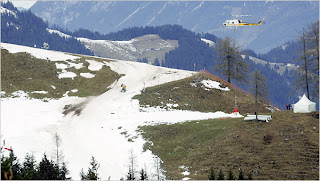 There is just so much wrong with this picture, which shows the desperate effort by organizers of World Cup ski races in Kitzbühel, Austria, to put enough snow on the slopes for races next weekend. To prepare the famous Hahnenkamm downhill course, organizers used a fleet of helicopters to fly 105,000 cubic feet of snow from a nearby high pass, making "hundreds of trips," according to the New York Times. Meanwhile, organizers outside Cortina, Italy, flew 51 helicopter sorties to carry man-made snow up to the course for a World Cup ski race this weekend. Europe, of course, has been experiencing record warmth and a dearth of snow. For the Hahnenkamm, the snow lift was too little too late: The downhill and Super-G were canceled today.
There is just so much wrong with this picture, which shows the desperate effort by organizers of World Cup ski races in Kitzbühel, Austria, to put enough snow on the slopes for races next weekend. To prepare the famous Hahnenkamm downhill course, organizers used a fleet of helicopters to fly 105,000 cubic feet of snow from a nearby high pass, making "hundreds of trips," according to the New York Times. Meanwhile, organizers outside Cortina, Italy, flew 51 helicopter sorties to carry man-made snow up to the course for a World Cup ski race this weekend. Europe, of course, has been experiencing record warmth and a dearth of snow. For the Hahnenkamm, the snow lift was too little too late: The downhill and Super-G were canceled today.
It's not really clear if global warming has anything to do with Europe's warm winter. (Last winter was exceptionally cold and snowy.) But let's just stipulate that, on average, the climate in Europe is getting warmer. And let's stipulate that CO2 from burning fossil fuels is a major contributor to climate change. Now, does it really seem like a good idea for ski resorts and ski-racing organizations whose very existence are threatened by climate change to fly hundreds of fuel-guzzling, CO2-speweing helicopter sorties in order to hold a ski race? Sure, there is major economic disruption for local people when a race as prestigious as this is canceled. But if ski resorts are going to get serious about preventing climate change, something's gotta give. A good place to start would be deciding not to helicopter snow up and down the mountains.
Posted by
Dougald MacDonald
at
3:25 PM
1 comments
![]()
![]()
54 14'ers, 12 Months
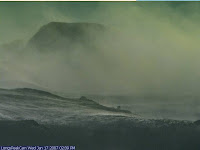 Chris Davenport succeeded yesterday in skiing Longs Peak, his 54th Colorado 14'er in less than 12 months. To be precise, he needed 363 days to become only the second person to ski all of the 14'ers from their summits. (The first was Lou Dawson, who needed 14 years; Sean Crossen has skied 53 of the 54 peaks over the last several years, with only Capitol eluding him.) Davenport skied the south side of the Front Range peak with Neal Beidleman and Nick Devore.
Chris Davenport succeeded yesterday in skiing Longs Peak, his 54th Colorado 14'er in less than 12 months. To be precise, he needed 363 days to become only the second person to ski all of the 14'ers from their summits. (The first was Lou Dawson, who needed 14 years; Sean Crossen has skied 53 of the 54 peaks over the last several years, with only Capitol eluding him.) Davenport skied the south side of the Front Range peak with Neal Beidleman and Nick Devore.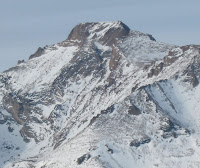 Davenport tried to ski Longs two days ago, but the wind was nuking (see top photo from midday on Wednesday) and his party never made it above the Boulderfield at about 12,500 feet on Longs' northern flank. On Friday, they climbed to the Loft, the saddle between Longs and neighboring Mt. Meeker, then traversed around the Palisades and, oh joy!, spotted enough snow on the Homestretch of Longs' Keyhole hiking route to allow a ski descent from the very top. This route depends on steep ramps of snow clinging to the Homestretch and the ledges beneath it to connect to Keplinger's Couloir and Wild Basin below. The photo here shows the south side on January 1, 2007, courtesy of Andy Moore, who was part of the first known party to ski the south face in May 2003, following the huge March blizzard that year. (You can see great photos and an account of that descent here.) After more than a week of wind, the face was a lot rockier yesterday, but Davenport and party found just enough snow to eke out a skiable line (with some rock skiing and a short rock downclimb well below the summit) and then thrash out the de-proach to the highway. See details and photos at Ski the 14'ers.
Davenport tried to ski Longs two days ago, but the wind was nuking (see top photo from midday on Wednesday) and his party never made it above the Boulderfield at about 12,500 feet on Longs' northern flank. On Friday, they climbed to the Loft, the saddle between Longs and neighboring Mt. Meeker, then traversed around the Palisades and, oh joy!, spotted enough snow on the Homestretch of Longs' Keyhole hiking route to allow a ski descent from the very top. This route depends on steep ramps of snow clinging to the Homestretch and the ledges beneath it to connect to Keplinger's Couloir and Wild Basin below. The photo here shows the south side on January 1, 2007, courtesy of Andy Moore, who was part of the first known party to ski the south face in May 2003, following the huge March blizzard that year. (You can see great photos and an account of that descent here.) After more than a week of wind, the face was a lot rockier yesterday, but Davenport and party found just enough snow to eke out a skiable line (with some rock skiing and a short rock downclimb well below the summit) and then thrash out the de-proach to the highway. See details and photos at Ski the 14'ers.
I could be accused of overblogging Davenport's quest (six entries in the last year), but I've found it incredibly inspirational. Davenport accomplished his feat with style (including a major first descent on Capitol) and an ever-present sense of excitement and humility.
Posted by
Dougald MacDonald
at
7:19 AM
1 comments
![]()
![]()
Thursday, January 18, 2007
Shallow Water Soloing
Inspired by deep-water soloing in Mallorca or just an entrepreneurial brainstorm? Either way, it's a brilliant idea. Aquaclimb has teamed with wall builder Pyramide USA since about 2005 to install these modular poolside climbing walls. The fiberglass panels and plastic holds extend up to about 10 feet above the water surface, and the panels can be rotated and holds moved to change the pattern. I'm not big on hanging out at swimming pools, but this would make the cruise-ship or hotel-lounging experience a bit more interesting. Although the basic routes don't look challenging to a "real" climber, the beauty of bouldering is that problems are limited only by the imagination.
Posted by
Dougald MacDonald
at
6:23 AM
2
comments
![]()
![]()
Tuesday, January 16, 2007
53 Down, 1 to Go
According to Wild Snow, Chris Davenport skied his 52nd and 53rd Colorado 14'ers over the weekend, Blanca and Shavano. Details likely will be posted at Davenport's web site later today. Davenport started his 14'er quest on January 22, 2006. So that gives him six days, counting today, to climb and ski Longs Peak, the monarch of Colorado's Front Range, in order to become the second person to ski all the 14'ers from their summits—and to do it in a single year. Longs is usually skied by its north face in May or June, and that's looking a bit sketchy this morning. Where the route narrows, just to climber's right of the Diamond face, there's about 125 feet of 55-degree rock and ice where the old Cables Route went up the mountain. Skiable right now? Most people wouldn't say so, but maybe Davenport will try it. Longs also has been skied from the summit via its southern aspect, picking a line down the steep Homestretch ramp of the Keyhole Route, then down the long gully system of Keplinger's Couloir. From a distance, it looks like there's more snow on the peak's southern side than the north face right now, but you can't see all of the Homestretch from the valley, so Davenport will have to get a recon report to decide which aspect to tackle. There's no new snow in the forecast, so the Front Range's notorious winds will probably decide Davenport's fate over the next couple of days. Even if he doesn't pull off a Longs descent this week, he'll likely tick his final 14'er in the spring. Either way—doing them in a year or in a year-plus—it's a magnificent achievement. As much as I wish Davenport well this week, I think in it's kind of cool that Mother Nature will have the final say.
Longs is usually skied by its north face in May or June, and that's looking a bit sketchy this morning. Where the route narrows, just to climber's right of the Diamond face, there's about 125 feet of 55-degree rock and ice where the old Cables Route went up the mountain. Skiable right now? Most people wouldn't say so, but maybe Davenport will try it. Longs also has been skied from the summit via its southern aspect, picking a line down the steep Homestretch ramp of the Keyhole Route, then down the long gully system of Keplinger's Couloir. From a distance, it looks like there's more snow on the peak's southern side than the north face right now, but you can't see all of the Homestretch from the valley, so Davenport will have to get a recon report to decide which aspect to tackle. There's no new snow in the forecast, so the Front Range's notorious winds will probably decide Davenport's fate over the next couple of days. Even if he doesn't pull off a Longs descent this week, he'll likely tick his final 14'er in the spring. Either way—doing them in a year or in a year-plus—it's a magnificent achievement. As much as I wish Davenport well this week, I think in it's kind of cool that Mother Nature will have the final say.
Posted by
Dougald MacDonald
at
8:16 AM
1 comments
![]()
![]()
Thursday, January 11, 2007
Too Much Advertising?
A comment on last week's post about the sale of Climbing magazine raises an interesting question: "Where you write that Climbing has to increase editorial, do you mean there is too much advertising in the magazine?" The answer is no, despite the frequently heard complaint that Climbing & Rock & Ice are "all ads." Readers would be much better off if the mags had more ads. Here's why.
Almost all modern magazines adhere to an ad-to-edit ratio: The more ads in a given issue, the bigger the magazine, and thus the more editorial pages for readers to enjoy (or to vilify, as the case may be). In the old days, the big U.S. climbing magazines ran much "looser" than they do today. Rock & Ice, which I operated for about five years, used to run as little as 30 percent advertising; George Bracksieck, the magazine's previous owner, published 148 pages each issue for many years no matter how few ads he sold; he did it by cutting expenses to the bone and by absorbing losses when he had to. In those days, Climbing magazine also ran loose, sometimes topping 200 total pages.
But starting in the late 1990s, two things happened that eventually shrank the magazines. First, both magazines got new ownership (Cowles/Primedia in Climbing's case; North-South Publications in Rock & Ice's), and both owners sought growth and a return on their investment. As the magazines added issues, they no longer could be produced with a couple of people in a garage (R&I) or the back room of an Aspen newspaper (Climbing). Combined with ever-increasing paper, printing, distribution, and editorial costs, the mags were forced to tighten up their ad-to-edit ratios, so that each page printed and distributed was more profitable. Both magazines now aspire to run about 50 percent ads, which brings them in line with the low end of magazine-industry standards.
(Interestingly, R&I typically runs more ads per edit page than Climbing does, but it looks like it has less, thanks to its new, larger format and a more open design. Climbing usually has a higher percentage of editorial but looks more crowded, thanks to a busier, more dense design. Comes down to which design aesthetic you prefer, I guess.) Tighter ad-edit ratios were fine when the climbing and ad businesses were booming. Both magazines were fat. But starting with the Nasdaq/dot.com crash in early 2000, advertising went into a tailspin. Those dot.com double-truck spreads vanished almost overnight (does anyone remember Quokka or Planet Outdoors?); automotive and other "non-endemic" advertising withered; and the biggest outdoor advertisers, like Gore, North Face, Mountain Hardwear, etc., cut their schedules significantly. Even the core climbing companies cut way back as the sport's meteroric growth through the mid-1990s flattened, and as companies began to experiment with the Internet, event sponsorship, and other forms of marketing. The result has been much smaller magazines: Climbing's most recent issue was just 84 pages, and R&I's was 92 pages. Granted, the first issue of the year is always the smallest for the climbing magazines, but no one is expecting a major ad boom in 2007.
Tighter ad-edit ratios were fine when the climbing and ad businesses were booming. Both magazines were fat. But starting with the Nasdaq/dot.com crash in early 2000, advertising went into a tailspin. Those dot.com double-truck spreads vanished almost overnight (does anyone remember Quokka or Planet Outdoors?); automotive and other "non-endemic" advertising withered; and the biggest outdoor advertisers, like Gore, North Face, Mountain Hardwear, etc., cut their schedules significantly. Even the core climbing companies cut way back as the sport's meteroric growth through the mid-1990s flattened, and as companies began to experiment with the Internet, event sponsorship, and other forms of marketing. The result has been much smaller magazines: Climbing's most recent issue was just 84 pages, and R&I's was 92 pages. Granted, the first issue of the year is always the smallest for the climbing magazines, but no one is expecting a major ad boom in 2007.
How can the mags deliver more editorial? Only two ways: Loosen the ad-edit ratio or sell more ads. Mark Crowther, who runs Urban Climber and just bought Climbing, seems to be promising a bit of the former (more editorial per ad page) for Climbing magazine. But the August-September issue of Urban Climber was almost 47 percent ads, right in there with the others. As you'd expect from a relatively new magazine, many of these were sponsorship or "house" (promotional) ads, but to the reader a free ad is the same as a paid ad—it still reduces the amount of editorial. Crowther may loosen Climbing's ratio a bit, but the only way readers of the big mags will see a significant increase in editorial pages is if they sell lots more advertising. I don't know about you, but I'd like to have more than 15 minutes of reading material in my climbing magazines. And that, dear readers, is why I think they don't have enough ads.
But wait, you say, what about Alpinist? Yes, Alpinist runs a very loose book—18.25 percent ads in its most recent 100-page issue—and readers love it for that. But even Alpinist has increased its ad-edit ratio significantly; it now runs about 40 percent more ads than it did in its first few years, with the same total page count. More importantly, the jury is still out on Alpinist's "reader supported" ($12.95 cover price) business model. Marc Ewing, the magazine's owner, has nearly pulled the plug at least once. Alpinst (and Climbing) have invested heavily in the Web in recent months, perhaps anticipating a day when the print mags are less important to the revenue picture. But print still drives the publishing businesss, and as long as print magazines are around they will depend on advertising.
Lecture over.
Posted by
Dougald MacDonald
at
6:14 AM
6
comments
![]()
![]()
Friday, January 05, 2007
Climbing Mag Sold; New Running Mag Coming?
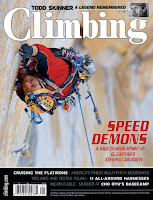
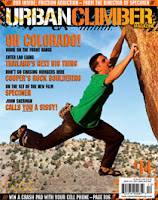 Climbing magazine has been purchased by Skram Media, publisher of Urban Climber; the NYC company is run by British-born Mark Crowther. Climbing magazine was sold by giant specialty publisher Primedia, which purchased the mag from Michael Kennedy in the mid-1990s. For now, word is that the magazine will stay in Carbondale, Colorado, with most of its current staff.
Climbing magazine has been purchased by Skram Media, publisher of Urban Climber; the NYC company is run by British-born Mark Crowther. Climbing magazine was sold by giant specialty publisher Primedia, which purchased the mag from Michael Kennedy in the mid-1990s. For now, word is that the magazine will stay in Carbondale, Colorado, with most of its current staff.
It will be very interesting to see how Crowther balances the two climbing rags in his portfolio. The U.S. climbing magazine spectrum currently has Urban Climber at one end, targeting young climbers (mostly boulderers), and Alpinist at the other end, catering mostly to traditional climbers and mountaineers, with Climbing and Rock & Ice in the middle, trying to cater to everyone. The established climbing magazines have been struggling to figure out how to appeal to younger readers, as their median age demos keep creeping upward, but Urban Climber, which launched in 2004, has been much more successful. I've been impressed with the magazine's lively feel and sharp imagery. Now that Urban Climber is in the same family, Climbing may be free to shift its focus slightly—maybe even go back to the future. For one thing, Crowther reportedly has told staff he'd like to see a return to "a more 80s-style openness" in the magazine layout. For those who don't remember, the climbing mags in the 1980s ran something like 30 percent ads, compared with today's 50 percent plus. (Alpinist has capitalized on this shift with its much more editorial-heavy design.) Climbing's ad count has been weak in recent years, despite its circulation dominance, and the magazine has shrunk dramatically as a result; anything Crowther can do to increase editorial pages would be a huge plus for readers. Climbing also might not feel quite so much pressure to target the youth market, which could yield more articles appealing to climbers in their 30s and 40s, who, after all, still make up a major chunk of the overall market (and spend the most money on gear). Finally, Crowther seems super-committed to online media; in late December he announced that Urban Climber's web site will relaunch with a major overhaul early this year. Climbing's web site is already the best climbing-mag site in the world (in my humble opinion), and as a frequent contributor I was relieved to hear that Crowther and Climbing only want to increase that dominance.
But all this is really guesswork. After any acquisition, many things change. Some new opportunities appear. Some people get hurt. As they say in Maine where I grew up: "Hard sayin', not knowin'."
Addendum: Whoa, just found this nugget buried in today's press release: "As well as growing existing magazines and websites, Skram Media's future plans include the launch of a trail-running magazine." Big Stone Publishing, which purchased Trail Runner magazine from my company in 2002 along with Rock & Ice, will be watching Crowther's moves very closely, I imagine!
Posted by
Dougald MacDonald
at
10:57 AM
5
comments
![]()
![]()
Thursday, January 04, 2007
Climbing With Eustace Tilley
The January 8 edition of The New Yorker has a decent piece of mountaineering fiction by Primo Levi, the Italian chemist and Holocaust writer who died in 1987. Apparently, Levi was an enthusiastic climber before World War II—his descriptions are spot on. I particularly liked this brief passage, describing the inevitable sizing up that happens whenever climbers congregate in the evening at a hut or campsite:
"I sat down at a table and opened my backpack. Across from me was a tall, large man, middle-aged, with whom I exchanged a few words about the weather and our plans for the following day. This is standard conversation, like the opening moves of a chess game, where what matters, much more than what one says (which is brief and obvious), is the tone in which one says it."
The short story can be found here today, but it will probably be replaced by next week's fiction piece very soon. Then you'll have to buy the issue, which is worthwhile anyway to see the spledid black-and-white photo of a mountaineering party casting beautiful shadows in the snow; it's a Corbis photo by an unnamed shooter from Mt. Hood, a peak I'm fairly certain Primo Levi never climbed.
Posted by
Dougald MacDonald
at
8:41 AM
0
comments
![]()
![]()
Wednesday, January 03, 2007
Annals of Obsession
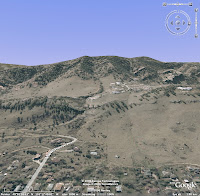 Dave Goldstein had a mission in 2006: He wanted to break his old record for climbing Mt. Sanitas, the Boulder, Colorado, foothill named for a tuberculosis hospital. I don't remember what his goal was, but he ended the year with 269 ascents. Now, Sanitas is just a bump on the way to the Rockies; it rises about 1,400 feet in a mile and a half or so above Dave's home. But think about it: 269 ascents means climbing the peak more than five days a week, year-round. Dave actually averaged more like six or seven days a week when he was at home, because he travels a lot to climb, reducing the number of potential Sanitas days. "I could have done even more ascents if I had a job," he said. There were snow days, too, though in Boulder the weather is rarely an obstacle. Still, he sometimes doubled up to keep the count progressing satisfactorily, climbing up the mighty East Face (facing the camera in this Google Earth image from above Dave's neighborhood), then hiking down the South Ridge, and then back up over the top for a twofer. Injuries also could have been a factor, but on January 2 Dave actually was lamenting the health effects of the end of his streak. "I think my body got addicted to climbing it," he said. "My back has been acting weird, and climbing Sanitas seemed to help."
Dave Goldstein had a mission in 2006: He wanted to break his old record for climbing Mt. Sanitas, the Boulder, Colorado, foothill named for a tuberculosis hospital. I don't remember what his goal was, but he ended the year with 269 ascents. Now, Sanitas is just a bump on the way to the Rockies; it rises about 1,400 feet in a mile and a half or so above Dave's home. But think about it: 269 ascents means climbing the peak more than five days a week, year-round. Dave actually averaged more like six or seven days a week when he was at home, because he travels a lot to climb, reducing the number of potential Sanitas days. "I could have done even more ascents if I had a job," he said. There were snow days, too, though in Boulder the weather is rarely an obstacle. Still, he sometimes doubled up to keep the count progressing satisfactorily, climbing up the mighty East Face (facing the camera in this Google Earth image from above Dave's neighborhood), then hiking down the South Ridge, and then back up over the top for a twofer. Injuries also could have been a factor, but on January 2 Dave actually was lamenting the health effects of the end of his streak. "I think my body got addicted to climbing it," he said. "My back has been acting weird, and climbing Sanitas seemed to help."
Posted by
Dougald MacDonald
at
7:33 PM
0
comments
![]()
![]()
Monday, January 01, 2007
A New Year
At the start of last year, I posted an incredibly ambitious (in hindsight) list of outdoor goals for 2006. Never mind how many I accomplished: Given the way the year turned out, I feel lucky just to have survived. It was a brutal year for the mountain community, with far too many deaths, among them Doug Coombs, J.C. Lafaille, Sue Nott, Karen McNeill, Todd Skinner, Hari Berger, and now Charlie Fowler and Chris Boskoff, to say nothing of the lesser-known adventurers whose lives were cut short. I have trouble just getting my head around the loss of so many strong, inspirational characters and, in some cases, old friends. To make matters worse personally, I just returned from a long-anticipated climbing trip to the Costa Blanca in Spain that turned into a disaster. On the very first day of our trip, on our way to the casita we had rented for 10 nights, our car was robbed of everything we had brought to Spain: clothes, climbing gear, computer, camera, etc., etc. We spent the next three days in a dismal round of shopping and bureaucracy, followed by four days of uncharacteristically cold and rainy weather that kept us mostly inside, watching DVDs and drinking way too much cheap wine. It did clear up eventually, and we got some fantastic climbing done (I'd show you pictures, but the bastards stole the USB cable for the one camera we still had). Frankly, we were lucky not to be injured by the thieves, whom we very nearly caught in the act. As I said, I feel fortunate just to have survived the year.
I didn't get to nearly as many of my goals for 2006 as I'd hoped, but I suppose that just leaves more opportunities for this year. Right now, though, I don't even feel like climbing—right now, the mountains just seem like the source of too much sadness. That will change. It's a fact—no less true for being a cliché—that the most valuable lesson we draw from the unexpected deaths of friends is to live each day to the fullest. One reason I didn't get as much done in the mountain world as I'd hoped in 2006 was too much writing and editing work. I'm proud of the work I did (and the money doesn't hurt, either), but if I made a list of resolutions for the New Year I'd top it with the desire to rebalance my life a bit and spend more time outside. So, right now, I'm going skiing.
Posted by
Dougald MacDonald
at
11:02 AM
2
comments
![]()
![]()




